Journal of Pollution Effects & Control
Open Access
ISSN: 2375-4397
ISSN: 2375-4397
Mini Review - (2022)Volume 10, Issue 2
Environmental challenges, especially global warming as well as energy supply scarcity, have prompted wide-ranging study regarding advanced thermal power generation. Due to their many benefits, thermoelectric power generators have arisen as an exciting potential renewable technology. Thermoelectric power generation could be utilized to immediate transformation of waste-heat resources to thermal power, without taking into account the expense of the thermal energy source. This use of the alternate solar technology for transforming waste-heat energy to thermal power would progress energy conversion device efficiency overall. This paper offers a viewpoint on thermoelectric power generation's basic principles, as well as an analysis and discussion of modern thermoelectric power generation with fascinating and practical waste-heat electricity applications.
Energy; Thermoelectric power; Electrical power; Waste-heat; Thermoelectric power generation
The term thermoelectric is derived from the terms thermo and electric, and as the name suggests, thermal refers to heat energy and electric refers to electrical energy. Thermoelectric power generators are instruments that transform the difference in temperature between two junctions into electrical energy [1]. The Seebeck effect controls the operation of thermoelectric generators. When the two junctions are held at varying temperatures, an Electromotive Force (EMF) forms in a loop between two dissimilar metals, according to this principle. As a consequence, it's also known as Seebeck power generation [2]. A thermo-electrical generator consists of a high-temperature source of heat as well as a heat sink which is held at a reduced temperature than that of the heat source. Owing to the temperature differential between the source of heat and the heat sink, electric current passes through the load. Since there is no intermediate energy transfer in this form of energy conversion, it is also known as direct power conversion [3].
The power generated by Seebeck power generation are single phase Direct Current (DC) and can be calculated using I^2 R_L or VI, where R_L is the load resistance. Increasing the temperature disparity between the cold and hot ends, or sequentially connecting several thermoelectric power generators, increases the output voltage as well as power. As long as heat is supplied to the hot junction and withdrawn from the cold junction, the current will begin to run. This DC current produced by thermoelectric or Seebeck power generation can be converted to Alternating Current (AC) using inverters, and its voltage level can be increased further using transformers. The energy transfer method used in thermoelectric or Seebeck power generation is reversible, which means that the route of flow of energy can be changed. Heat can be quickly pulled from the thermoelectric power generator if the load is removed and DC power is applied across the terminals where the load was involved (Figure 1), with thermoelectric power generation (also known as thermoelectricity).
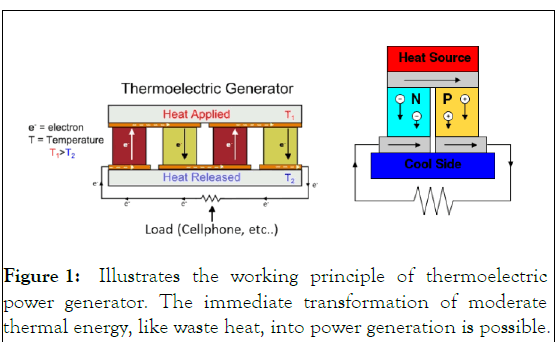
Figure 1: Illustrates the working principle of thermoelectric power generator. The immediate transformation of moderate thermal energy, like waste heat, into power generation is possible.
The thermoelectric power source is a solid-state system that uses the Seebeck effect to convert thermal energy (heat) produced by a temperature gradient through electrical energy. The thermoelectric power phase, which uses charged particles (electrons) as the working fluid, is closely similar to the power cycle of a typical heat engine and obeys thermodynamics fundamental laws. Low conversion efficiency among thermoelectric power generators becomes their biggest drawback. It has become a key factor in restricting their use during electrical power generation to niche applications where reliability is important but expense is not. Industrial instruments, defense, clinical, and aerospace systems, as well as mobile or remote power generation, will all have been used in the last decade. Despite these challenges, the worry about ecological pollution, particularly global warming, have triggered thorough research in recent decades into alternative electrical power generation systems, with thermoelectric energy production emerging as a possible green technology option [4].
Excess heat is drained in vast amounts into the environment, the bulk of which would be at temperatures sufficiently low for conventional electrical power plants to retrieve. The immediate transformation of moderate thermal energy, like waste heat, into power generation is possible with generation of thermoelectric power (thermoelectricity). As substitute to expensive gasolinepowered motor engines, thermoelectric generators were being used to supply limited quantities of electricity to rural areas like as Northern Sweden. The low conversion efficiency of thermoelectric power generators isn't really a major drawback of this waste heat driven thermoelectric technology because the cost of the thermal energy source is irrelevant. They can be used to improve total energy conversion system profitability through turning waste-heat resources into usable electricity in some ways, which are often utilized in cogeneration systems [5].
In particular, the expense of a thermal power generator is determined by combination of two parts i.e., the cost per facility and the cost per service. The unit cost is measured by the cost of construction to achieve the required electrical power output, whereas the operating cost is calculated by the engine's output performance. Thermoelectricity utilizes heat energy which is extracted from the waste would be ideal application because a module's conversion efficiency is comparatively low. Since the energy input (fuel) cost is low or free in this situation, the maintenance cost is marginal in comparison to the module cost. As a result, lowering the cost-per-watt of the systems is a significant goal in thermoelectricity using heat energy extracted from the waste. Furthermore, cost/watt minimized by refining device geometry, enhancing production efficiency, or simply by increasing the temperature differential between the system and the ambient temperature. In particular, several research studies have focused on improving thermoelectric characteristics of materials and improving systems in the design of advanced thermoelectric power plants. More innovative thermoelectric technologies and thermoelectric power unit prototypes remains critical to their efficiency and economic viability [6].
Advantages of thermoelectric power generators
• Able to operate at extreme temperatures.
• Possibly the best suitable for small and distant applications likely of remote energy sources, where power is scarce or not existing.
• Remarkably robust and quiet in service due to the absence of physical working components, and they require considerably less maintenance due to their simplicity, durability, safety, compact size, and absolute weightlessness.
• Environmentally friendly.
• Not influenced by their location, and
• Capable of adapting energy sources.
Thermal power plant
The most famous origin for electric power is indeed a thermal power plant, often regarded mostly as thermal power station. Coal thermal power plants and steam turbine power plants are examples of thermal power plants. Theoretically, or in terms of how they function, thermal power plants are very simple. An alternator powered by a steam engine is the heart of a power generation plant. Boilers with high pressure produce steam. Bituminous coal, peat as well as brown coal used in India are considered as typical boiler fuels. Bituminous coal has a volatile matter comprising of 8-33% including an ash comprising of 5-16%. Coal powder is being utilized in the furnace to increase thermal efficiency. The burning of fuel in boiler furnaces creates high-pressure steam in a coal thermal power plant's steam boiler. In a super-heater, the steam is heated even further. The engine is then filled with superheated steam, which spins the turbine blades [7]. The alternator's rotor rotates in parallel with the rotor wheels due to the fact that the rotor is physically attached to it. The steam pressure has dropped dramatically after entering the turbine, although the steam flow has increased. Steam runs out from the rotor wheels into the condenser after providing energy to a turbine shaft. Cold water is injected into the cooling system with the assistance of a compressor that crystallizes the moderate wet steam. This cooled water is then transferred into some kind of low-pressure water furnace, whereby low-pressure gas increases the temperature of the treated wastewater until it has been warmed at higher pressure levels (Figure 2).
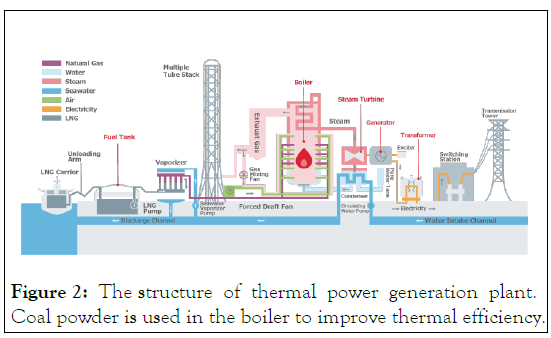
Figure 2: The structure of thermal power generation plant. Coal powder is used in the boiler to improve thermal efficiency.
The following is a list of each phase in the process of thermal power plant for a better understanding:
• The pulverized coal is first burned throughout the vapor boiler's furnace, which emits high-pressure gas.
• This vapor is first pumped into super-heater, where it is heated even more, before being transferred to a high-velocity turbine.
• The turbine blades are spun by vapor, turning the high compressed vapor's latent potential energy to mechanical power.
Thermal power plant’s line diagram
• Promptly just after rotor wheels have accelerated, the vapor loses its high pressure, escapes the turbine blades then reaches a cooling system.
• A fan pumps cool water into the condenser, crystallizing moderate vapors.
• Until being warmed inside a high-pressure burner having high steam pressure, the condensed liquid is first supplied into a moderate heating system, in which low-pressure steam raises the temperature of input water.
• In a thermal power station, the rotor serves as the alternator's key mover (Figure 3).
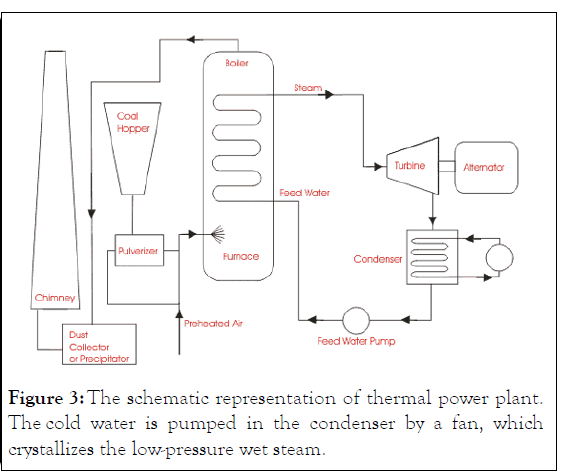
Figure 3: The schematic representation of thermal power plant. The cold water is pumped in the condenser by a fan, which crystallizes the low-pressure wet steam.
Summary of thermal power plant
The operating liquids are water as well as vapor. The rankine cycle is the best thermodynamic cycle for simulating the activity of a thermal power plant. The water inside a steam boiler is warmed by burning fuel throughout the furnace's air, as well as the purpose of the furnace is to deliver dry hot water at almost the right temperature. The steam supplied powers the steam turbines. This turbine is linked to the induction generator, which generates electricity [8]. The turbine's intake steam condenses into the water inside the steam condenser, causing the turbine's gas to expand to the much reduced pressure by creating partial vacuum at a rather low pressure. The operatingperiod of a conventional thermal power plant is seen below (Figure 4).
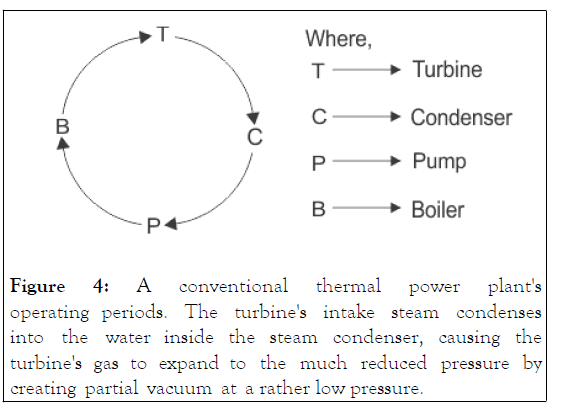
Figure 4: A conventional thermal power plant's operating periods. The turbine's intake steam condenses into the water inside the steam condenser, causing the turbine's gas to expand to the much reduced pressure by creating partial vacuum at a rather low pressure.
The elevated total energy generated per kg of vapor, which improves performance, as well as the condensate which is already pumped back to the reactor, which decreases the impact of fresh feed steam needed, are the two main advantages of condensing. A pump returns the vapor to the furnace, together with some fresh treated wastewater. Inside the condenser, coolant condenses vapor. Cooling water is recycled in the cooling system. The boiler is permitted to absorb atmospheric air after dust filtration. Flue gas also exits the boiler and is discharged into the air using stacks. There are air and flue gas circuits. The diagram below illustrates the general layout of a modern thermal power plant, including various circuits (Figure 5).
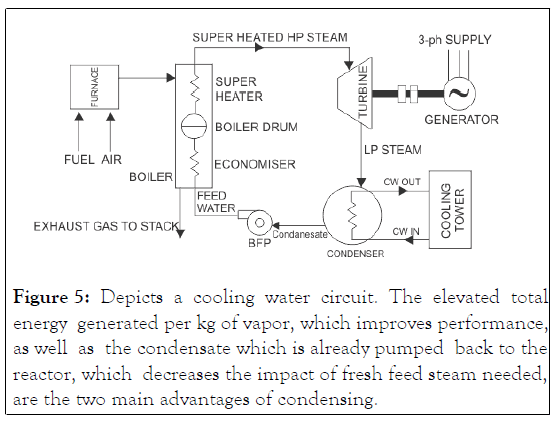
Figure 5: Depicts a cooling water circuit. The elevated total ener gy generated per kg of vapor, which improves performance, as well as the condensate which is already pumped back to the reactor, which decreases the impact of fresh feed steam needed, are the two main advantages of condensing.
An economizer, an evaporator, and a super heater are among the heat exchangers found within the boiler. The economizer uses the remaining heat from the flue gas to heat the feed water [9].
Thermal power plant’s effectiveness
The energy equivalent of output power divided by the energy of burning coal is used to determine the efficiency and capability of the thermal power plant. The average productivity of a thermal power station or plant ranges from 20% to 26%, depending on plant size (Table 1).
| Installed plant capacity | Average overall thermal efficiency |
|---|---|
| Up to 1 MW | 4% |
| 1 MW to 10 MW | 12% |
| 10 MW to 50 MW | 16% |
| 50 MW to 100 MW | 24% |
| Above 100 MW | 27% |
Table 1: The capacity of the various installed plant and its overall thermal efficiency. The average thermal efficiency is observed to be maximum in case of plant capacity above 100.
Thermoelectric power plants like a cost-effective renewable energy source
According to a report released, huge power plants focused on thermoelectric effects, like minor temperature differences in ocean water, might produce electricity for less capital than photovoltaic power stations. This paper addresses an ambitious concept for large-scale renewable power plants that takes control of the world's largest free and sustainable energy reserve while being cost-effective. This is because the sun raises the temperature of surface water across tropical countries to about 20 degrees Celsius more than the water 600 meters below [8].
Thermoelectric power plants generate electricity by pumping cold water from thousands of yards below the sea up into some kind of long channel using the strength of ocean waves. When cold water reaches the environment, it goes into a heating system and is then warmed by surface water from the outside. Since the tubes are constructed of thermoelectric substances that can transfer heat through their surfaces and directly transform temperature fluctuations into energy, the heat exchanger functions as just an electric generator. Marine thermoelectric power plants could have a range of benefits, for one aspect, the fuel is unregulated in the context of temperature variations, unlimited, and readily available. In addition, the plants do not take up much room. Since there are no rotating solid components, they will have low maintenance costs (Figure 6).
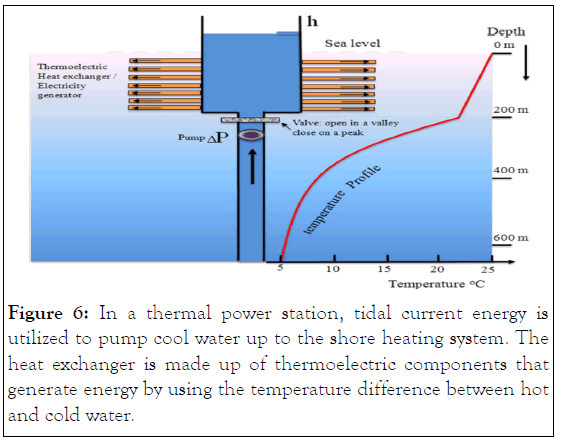
Figure 6: In a thermal power station, tidal current energy is utilized to pump cool water up to the shore heating system. The heat exchanger is made up of thermoelectric components that generate energy by using the temperature difference between hot and cold water.
Concerns about emissions, especially global warming, and electricity supply constraints have prompted extensive research into new electrical power generation technologies. Furthermore, a significant amount of excess heat is emitted into the atmosphere. Thermoelectric power generation is a promising technique for directly converting waste heat energy to electricity. This paper offers a concise description of thermoelectric power generation's basic concepts, as well as an analysis and discussion of recent thermoelectric power generation with fascinating and practical waste-heat electricity applications. The rate of heat excess power which thermoelectric generators could explicitly transform into electrical power specifies whether such implementations are small or large. As a result, nanotechnology is predicted to become more prevalent in these applications in the future. The macro-scale waste heat applications included domestic, truck, industrial, and solid waste heat.
Significant volumes of surplus heat are presently released by industry, like coal plants as well as power grids. As a consequence, the majority of recent research into thermoelectric power generation has centered on the utilization of commercial waste heat. Long term research in this field could concentrate on creating more suitable thermoelectric products that can sustain higher temperatures from different commercial heat sources while still delivering adequate efficiency at a fair cost. Some other future choice is to create new thermoelectric system configurations and modifications.
Citation: Nagappan B (2022) Thermal Power Generation Utilizing Waste Heat Energy. J Pollut Eff Cont. 10:332.
Received: 04-Mar-2022, Manuscript No. JPE-22-46546; Editor assigned: 09-Mar-2022, Pre QC No. JPE-22-46546 (PQ); Reviewed: 23-Mar-2022, QC No. JPE-22-46546; Revised: 29-Mar-2022, Manuscript No. JPE-22-46546 (R); Published: 05-Apr-2022 , DOI: 10.35248/ 2375-4397.22.10.332
Copyright: © 2022 Nagappan B. This is an open-access article distributed under the terms of the Creative Commons Attribution License, which permits unrestricted use, distribution, and reproduction in any medium, provided the original author and source are credited.